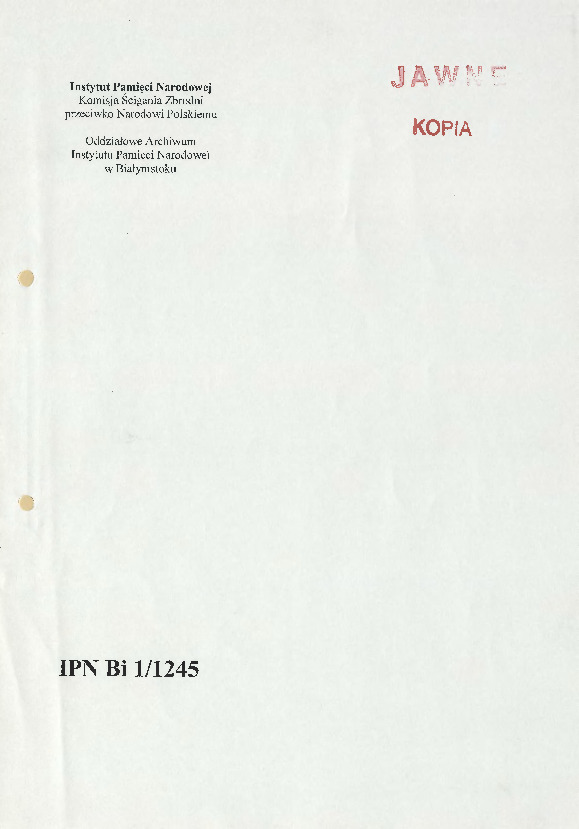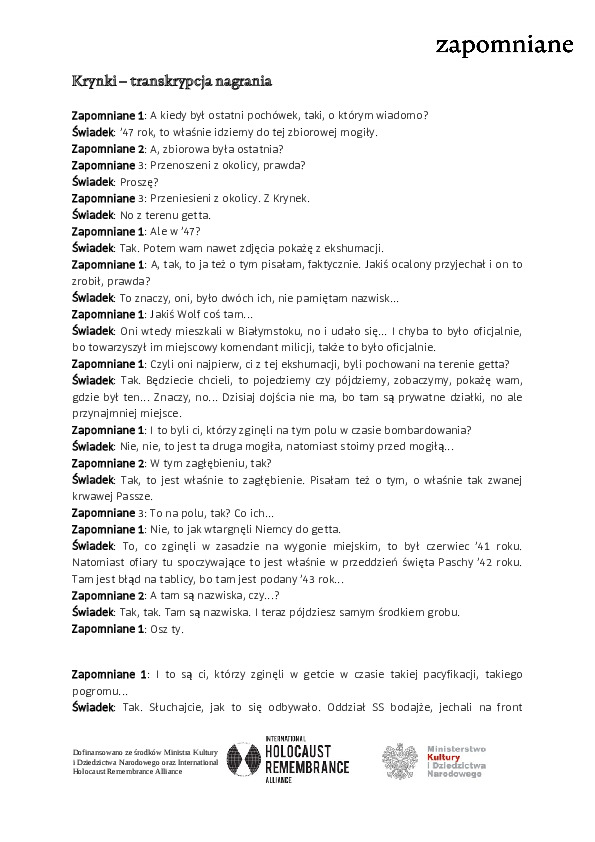Krynki
Borough of Krynki, Sokólski District, Podlaskie VoivodshipType of place
Jewish cemetery in Krynki.Information about the crime
The resources of The Chief Commission for the Examination of German Crimes in Poland contain information on the following events in Krynki:
In 1941, 325 people, Jews and Soviet prisoners of war, were murdered during three executions. The victims were buried in common and individual graves. One of them is located on the road leading to Sokółka, and the other on the road towards Grodno.
According to the account of the survivor Chaim Wejner, on June 29, 1941, there was a massacre of the Jewish population gathered in the fields around Krynki, who fled the city after receiving the news about the entry of the German army. The field on which they stayed was bombed. About seventy Jewish men, women and children were killed as a result of the shelling. They were buried in a mass grave at the Jewish cemetery in Krynki. (301/1288 AŻIH)
In the Memorial Book of Jews from Krynku there is an account of the massacre that took place on the evening of Pesach in 1942. In the morning, a two-hundred-strong Gestapo unit entered the Jewish district. The Germans scattered through the streets of the ghetto, burst into houses, killed and tortured the encountered Jews. Several dozen people died within two hours, including members of the rabbinical court. The bodies of the victims were buried in the ghetto. (Pinkus Krynki, Tel Aviv 1970) In December 1947, at the initiative of a handful of survivors, 40 bodies of the massacre victims were exhumed. Their remains were buried at the Jewish cemetery in Krynki. (301/3154 AŻIH)
On November 2, 1942, the ghetto in Krynki was liquidated, and only a group of craftsmen remained. The rest died in the gas chambers ofTreblinka death camp.
In August 1988, Konstanty K. testified before The Chief Commission for the Examination of German Crimes in Poland as follows:
“On a winter day, after the liquidation of the ghetto in Krynki, I saw German officers, passing our house towards the local Jewish cemetery, and escorting a group of 7 people of Jewish origin. I knew some of them. There were: Josiel Golc with his wife, Stolarski with his wife, brother of Stolarski’s wife, Itkin from Wielka Brzostowica [now in the territory of Belarus] and one man I didn’t recognize. After a dozen or so minutes, I heard the sounds of shots. A few minutes later, the military policemen or uniformed Germans from another formation were returning from the cemetery, but without the Jews. I found out that the above-mentioned Jews were shot and their bodies were buried in this cemetery. They remain there until today. These Jews were hiding in the synagogue in Krynki. Traces left by one of them in the fresh snow revealed their hiding place. German police officers were there at that time. They followed these traces to the synagogue and captured the hiding Jews. At that time, no one was allowed to stay in the area of the liquidated ghetto, and the traces on fresh snow were visible from a distance.” (IPN Bi 1/1245)
In 1943, 275 Jews, including 10 women, were killed in Krynki. The murders took place in the ghetto and outside its borders. The bodies of the victims were buried in a mass grave at Grochowa street in Krynki. (IPN BU 2448/45 and IPN BU 2448/46)
Sources
Transkrypcje
Contact and cooperation
We are still looking for information on the identity of the victims and the location of Jewish graves in Krynki. If you know something more, write to us at the following address: fundacjazapomniane@gmail.com.
Bibliography
IPN BU 2448/45 The Chief Commission for the Examination of German Crimes in Poland, Institute of National Remembrance, mill near Krynki
IPN Bu 2448/45, surveys of The Chief Commission for the Examination of German Crimes in Poland
IPN Bu 2448/46, surveys of The Chief Commission for the Examination of German Crimes in Poland
IPN Bi 1/1245 files of the former Regional Commission for the Examination of German Crimes in Białystok
301/1288 AŻIH (relacja Chaima Wajnera)
301/3154 AŻIH (relacja Szmula Wolfa)
Pinkus Krynki, Tel Aviv 1970
 Młyn koło Krynek Komisja Ścigania Zbrodni przeciwko Narodowi Polskiemu Krynki
Młyn koło Krynek Komisja Ścigania Zbrodni przeciwko Narodowi Polskiemu Krynki Krynki - transkrypcja nagrań
Krynki - transkrypcja nagrań